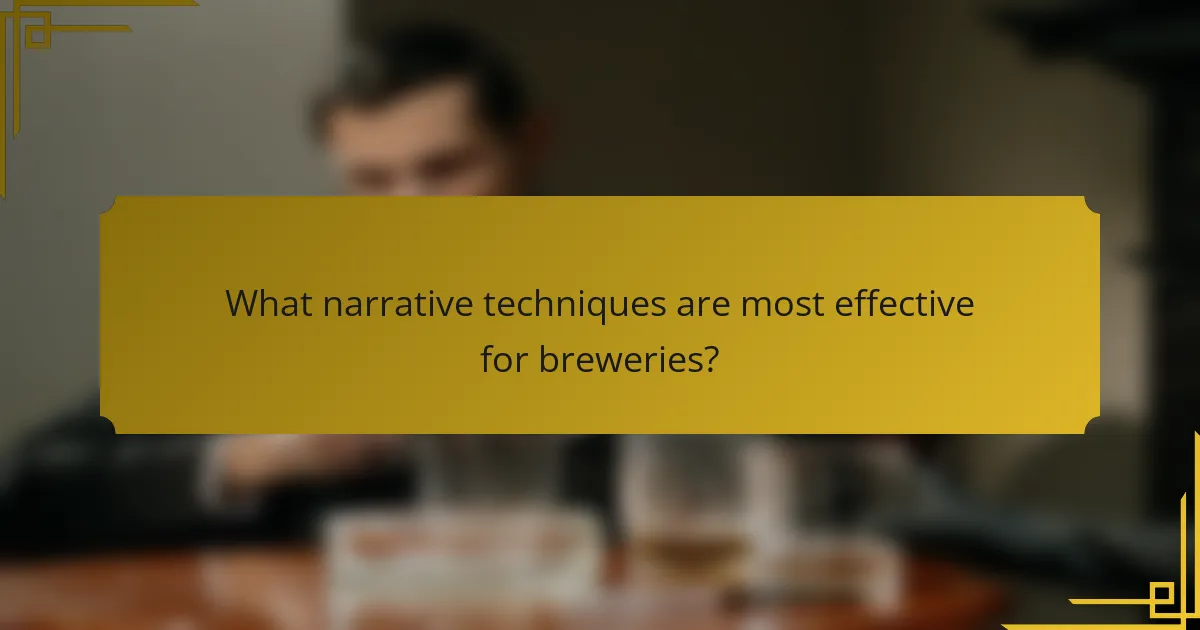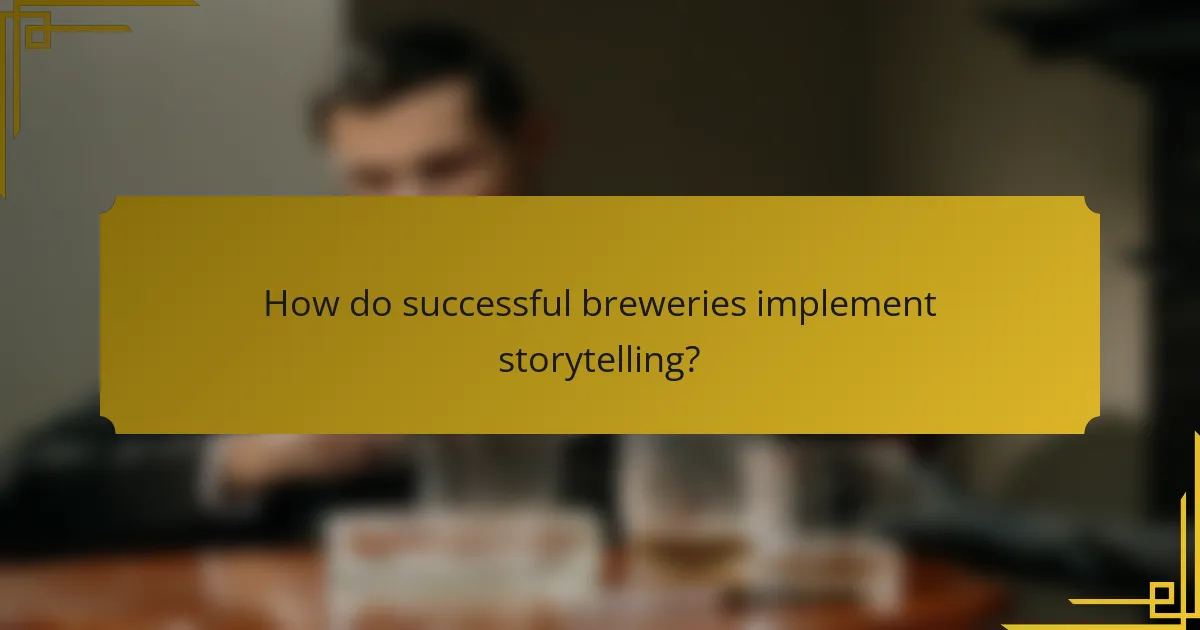Brewery brand storytelling is a powerful tool for creating authentic narratives that resonate emotionally with consumers. By incorporating personal experiences, local history, and community engagement into their stories, breweries can forge deeper connections with their audience, fostering loyalty and a sense of belonging. Engaging storytelling, combined with interactive experiences and digital platforms, enhances brand visibility and strengthens community ties.

How can breweries enhance brand storytelling?
Brewery brand storytelling can be enhanced by creating authentic narratives that resonate emotionally with consumers. By weaving personal experiences, local history, brewing processes, and community engagement into their stories, breweries can foster deeper connections with their audience.
Utilizing personal narratives
Personal narratives allow breweries to share the unique journeys of their founders, brewers, or even loyal customers. These stories can highlight challenges, triumphs, and the passion behind the craft, making the brand more relatable. For instance, a brewery might share how a family recipe inspired its flagship beer, creating a personal touch that resonates with drinkers.
Breweries should consider using various formats for these narratives, such as blog posts, videos, or social media stories. Engaging storytelling can turn a simple beer into a memorable experience, encouraging customers to share their own stories in return.
Incorporating local history
Integrating local history into brand storytelling helps breweries establish a sense of place and community. By highlighting historical events, landmarks, or cultural traditions, breweries can create a narrative that connects their products to the local heritage. For example, a brewery might name its beers after significant local figures or events, reinforcing its ties to the community.
Incorporating local history can also involve collaborating with local historians or cultural organizations to ensure accuracy and depth. This approach not only enriches the brand’s story but also fosters goodwill among local patrons who appreciate the recognition of their shared history.
Showcasing brewing processes
Showcasing the brewing process can demystify the craft and engage consumers by providing insight into how their favorite beers are made. Breweries can use visual storytelling through videos or behind-the-scenes tours to highlight the ingredients, techniques, and care that go into each batch. This transparency builds trust and appreciation among consumers.
Breweries should consider hosting events or workshops where customers can experience the brewing process firsthand. This not only enhances the storytelling aspect but also creates memorable interactions that strengthen brand loyalty.
Engaging with community events
Engaging with community events allows breweries to connect with their audience on a personal level while enhancing their brand story. Participating in local festivals, farmers’ markets, or charity events can showcase the brewery’s commitment to the community. This involvement can be highlighted in marketing materials, reinforcing the brewery’s role as a community partner.
Breweries should actively promote their participation in these events through social media and newsletters. Offering exclusive tastings or limited-edition brews at these events can create excitement and encourage community members to share their experiences, further amplifying the brand’s narrative.

What emotional connections can breweries create?
Brewery brands can foster emotional connections by aligning their narratives with the values and experiences of their audience. These connections often lead to brand loyalty and a sense of community among consumers who share similar beliefs and experiences.
Building brand loyalty through shared values
Breweries can cultivate loyalty by emphasizing shared values such as sustainability, local sourcing, or community support. For instance, a brewery that uses organic ingredients and supports local farmers can resonate with environmentally conscious consumers.
Highlighting these values in marketing materials and storytelling can create a deeper bond with customers, encouraging them to choose that brand over others. Engaging with the community through events or partnerships can further reinforce this loyalty.
Creating memorable experiences
Memorable experiences are vital for establishing emotional connections. Breweries can host events like tastings, brewery tours, or seasonal festivals that allow customers to engage with the brand in a unique way. These experiences create lasting memories that customers associate with the brand.
Additionally, storytelling through these events—sharing the history of the brewery or the inspiration behind a particular brew—can enhance the emotional impact. Personal interactions with staff can also make customers feel valued and connected.
Using sensory storytelling techniques
Breweries can leverage sensory storytelling to evoke emotions and create connections. This involves using taste, smell, and visual elements to craft a narrative around their products. Descriptive language in marketing can help consumers imagine the flavors and aromas, enhancing their anticipation and enjoyment.
For example, a brewery might describe the rich, malty aroma of a stout or the crisp, refreshing taste of a lager, allowing customers to visualize and experience the product before even tasting it. Incorporating visuals, such as vibrant labels or engaging social media content, can further amplify this sensory experience.

How can breweries effectively engage their audience?
Breweries can effectively engage their audience by creating authentic connections through storytelling, interactive experiences, and leveraging digital platforms. By focusing on emotional resonance and community involvement, they can foster loyalty and enhance brand visibility.
Leveraging social media platforms
Social media platforms are essential for breweries to connect with their audience in real-time. Utilizing channels like Instagram, Facebook, and Twitter allows breweries to share their brand story, showcase new products, and engage with customers through comments and direct messages.
To maximize engagement, breweries should post regularly and use high-quality visuals that reflect their brand identity. Running targeted ads can also help reach specific demographics, increasing brand awareness and attracting new customers.
Hosting interactive events
Hosting interactive events, such as brewery tours, tastings, and seasonal festivals, can significantly enhance audience engagement. These events provide opportunities for customers to experience the brand firsthand, fostering a deeper emotional connection.
Breweries should consider collaborating with local musicians or food vendors to create a festive atmosphere. Offering exclusive merchandise or discounts during events can also incentivize attendance and encourage social sharing.
Encouraging customer-generated content
Encouraging customer-generated content is a powerful way for breweries to build community and authenticity. By inviting customers to share their experiences through photos, reviews, or social media posts, breweries can create a sense of belonging and loyalty among their audience.
Breweries can facilitate this by creating specific hashtags or running contests that reward customers for sharing their content. Highlighting user-generated content on the brewery’s own social media channels can further strengthen this connection and showcase the community’s involvement.

What narrative techniques are most effective for breweries?
Effective narrative techniques for breweries include crafting compelling story arcs, developing character-driven narratives, and utilizing visual storytelling through packaging. These methods help create emotional connections with consumers, enhancing brand loyalty and engagement.
Story arcs in marketing campaigns
Story arcs in marketing campaigns guide the audience through a journey, often highlighting the brewery’s origins, values, and unique offerings. A well-structured arc typically includes a beginning that introduces the brand, a middle that showcases challenges or milestones, and an end that emphasizes achievements or community impact.
For example, a brewery might share its founding story, detailing the passion behind its first brew and the obstacles faced in scaling production. This narrative can resonate deeply with customers who appreciate authenticity and perseverance.
Character-driven brand narratives
Character-driven narratives focus on the people behind the brewery, such as founders, brewers, or community members. These stories humanize the brand, making it relatable and engaging for consumers. Highlighting personal experiences, values, and motivations can foster a stronger emotional connection.
For instance, a brewery could feature interviews with its brewmaster, sharing insights into their brewing philosophy and personal anecdotes. This approach not only builds trust but also invites customers to feel part of the brewery’s journey.
Visual storytelling through packaging
Visual storytelling through packaging is crucial for breweries to convey their brand narrative at first glance. Eye-catching designs, colors, and imagery can evoke emotions and communicate the essence of the beer, such as its flavor profile or the story behind its creation.
Consider using illustrations that reflect local culture or historical elements relevant to the brewery. This not only enhances shelf appeal but also invites consumers to explore the story behind the product, encouraging them to choose your brand over competitors.

What frameworks can breweries use for storytelling?
Brewery storytelling frameworks help create compelling narratives that resonate with consumers. By employing structured approaches, breweries can enhance emotional connections and engage their audience effectively.
Brand storytelling framework
The brand storytelling framework focuses on crafting a narrative that reflects the brewery’s identity, values, and mission. It typically includes elements such as the origin story, the brewing process, and the community impact. For example, a brewery might highlight its local sourcing of ingredients or its commitment to sustainability.
To implement this framework, breweries should identify key themes that resonate with their target audience. Consider using a mix of personal anecdotes and factual information to create a relatable and authentic story. Avoid overly complex narratives; clarity and simplicity are crucial.
Emotional engagement matrix
The emotional engagement matrix categorizes different emotional responses that a brewery’s story can evoke, such as joy, nostalgia, or pride. By mapping out these emotions, breweries can tailor their messaging to elicit specific feelings from their audience. For instance, a brewery might evoke nostalgia by sharing stories about family traditions associated with beer consumption.
When utilizing this matrix, breweries should assess their audience’s emotional triggers and align their storytelling accordingly. This can involve testing different narratives to see which ones resonate most. Keep in mind that strong emotional connections can lead to increased brand loyalty and advocacy.

How do successful breweries implement storytelling?
Successful breweries implement storytelling by weaving their brand narratives into every aspect of their operations, from product development to marketing. This approach fosters an emotional connection with consumers, enhancing audience engagement and loyalty.
Case study: Sierra Nevada Brewing Co.
Sierra Nevada Brewing Co. exemplifies effective storytelling through its commitment to sustainability and quality. The brewery shares its journey from a small homebrewing operation to a major player in the craft beer industry, emphasizing its roots in California’s Sierra Nevada mountains.
By highlighting its dedication to environmental stewardship, such as using renewable energy and sustainable ingredients, Sierra Nevada builds a narrative that resonates with eco-conscious consumers. This connection not only enhances brand loyalty but also attracts new customers who value sustainability.
Case study: Dogfish Head Craft Brewery
Dogfish Head Craft Brewery stands out for its innovative approach to storytelling, often using unconventional ingredients and brewing techniques. The brewery shares tales of its adventurous spirit, inviting customers to explore unique flavors and experiences.
Through engaging content, such as podcasts and social media posts, Dogfish Head creates a community around its brand. This narrative fosters a sense of belonging among consumers, encouraging them to participate in the brewery’s journey and share their own experiences with the brand.

What are the emerging trends in brewery storytelling?
Emerging trends in brewery storytelling focus on authenticity, community engagement, and sustainability. Breweries are increasingly using narratives that resonate emotionally with their audience, emphasizing local ingredients and cultural heritage.
Authenticity in Brand Narratives
Authenticity is crucial in brewery storytelling, as consumers are drawn to brands that reflect genuine values and practices. Breweries can achieve this by sharing their founding stories, the inspiration behind their recipes, and the people involved in the brewing process.
For instance, a brewery might highlight its use of locally sourced ingredients and the relationships it maintains with local farmers. This not only builds trust but also strengthens the emotional connection with the audience.
Community Engagement and Local Focus
Community engagement is a significant trend, with breweries actively participating in local events and initiatives. By hosting community gatherings, sponsoring local sports teams, or collaborating with nearby businesses, breweries can foster a sense of belonging and loyalty among their customers.
For example, a brewery could organize a monthly event featuring local artists or musicians, creating a platform for community talent while promoting its brand. This approach not only enhances visibility but also deepens customer relationships.
Sustainability and Environmental Responsibility
Sustainability is becoming a central theme in brewery storytelling, as consumers increasingly prefer brands that prioritize environmental responsibility. Breweries can showcase their sustainable practices, such as using renewable energy, recycling water, or implementing eco-friendly packaging.
Highlighting these efforts can resonate with environmentally conscious consumers. A brewery might share its journey toward zero waste or its commitment to reducing carbon emissions, reinforcing its dedication to the planet and attracting like-minded customers.
